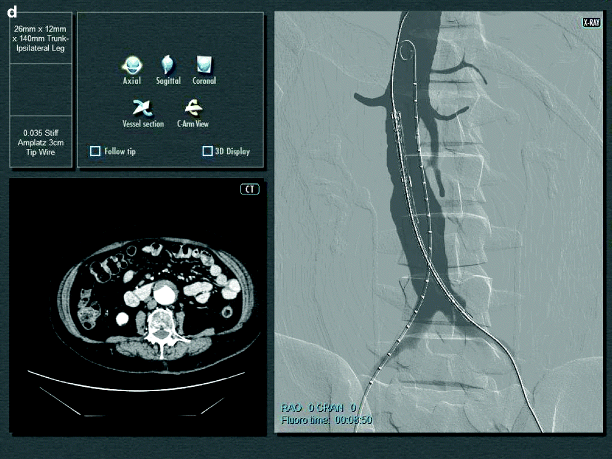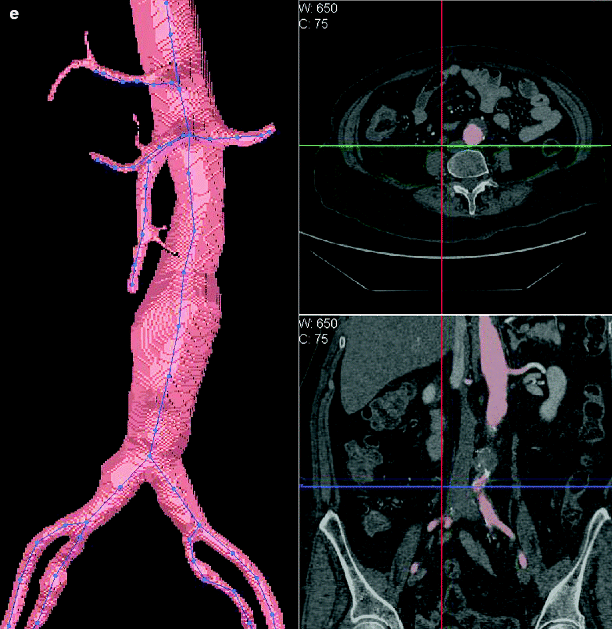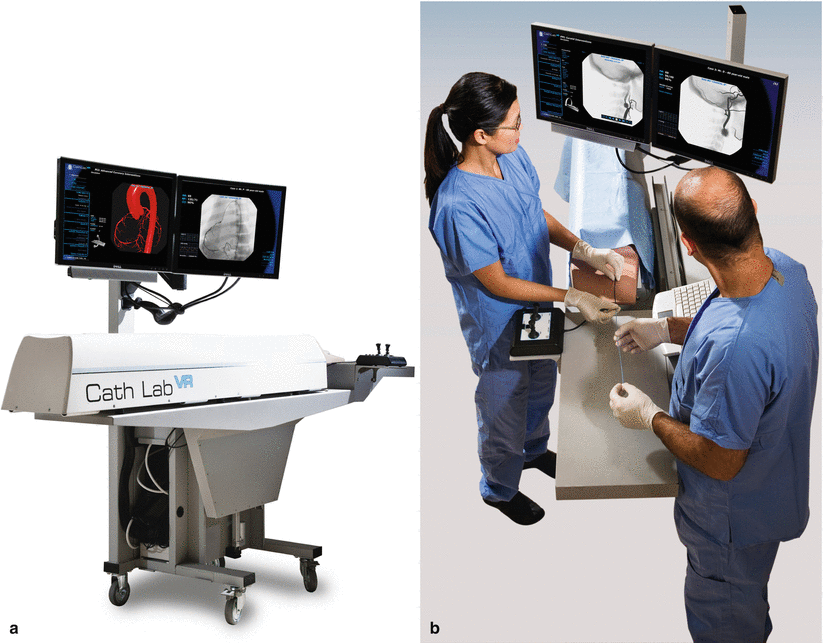

Fig. 39.1
Simbionix AngioMentor: (a) AngioMentor workstation, (b) workstation with projected image (note physiologic data inlay), (c) virtual angiographic image, (d) CT image corresponding to fluoroscopic views of abdominal aortic aneurysm, and (e) vascular segmentation workstation showing aortic pathology and corresponding CT images (Photos used courtesy of Simbionix)
Even though research has not been performed confirming that the training users receive on this simulator is able to be transferred to real patients, research has confirmed that the AngioMentor can reliably discriminate between different levels of experience when performing a percutaneous endovascular carotid stenting procedure, thus demonstrating construct validity [20]. This has led to two further device versions including the AngioMentor Express (portable version) and the AngioMentor Express dual access (for use in challenging endovascular procedures that require two access sites in the same intervention).
The Simsuite SIMANTHA® (Medical Simulation Corporation, Denver, CO) is a larger, high-fidelity simulator system incorporating situations with multiple events, immediate feedback, and high sensory load, with up to six interactive screens to facilitate multidisciplinary team training. This system also includes response to patient physiology features, as well as covering the procedural and skills training of the entire process of care.
A study performed using this simulator showed significant improvement in the technical skills of nine residents over a 3-day period following simulator-based training [21]. The residents significantly improved in three categories, including total procedure time (decreased 54%), volume of contrast (decreased 44%), and fluoroscopy time (decreased 48%) in repeated simulation-based testing.
The CathLabVR™ (CAE, Montreal, Quebec) also boasts peripheral arterial, carotid, renal, and coronary simulation modules with metrics-based assessment. To date no significant transfer of training study has been carried out with this simulator. There has, however, been evidence for construct validity for cardiac lead placement, which differentiated procedural efficiency (less time in procedure and in fluoroscopy and better tissue visualization by X-ray) among three cohorts according to their experience level [22] (Fig. 39.2).




Fig. 39.2
CAE Cath Lab VR: (a) Cath Lab VR workstation, (b) participants performing cerebral angiogram, and (c) screen shot of coronary and aortic angiogram (Photos courtesy of CAE Healthcare ©2012 CAE Healthcare)
The latest endovascular simulator that has shown transfer of training is the ImaGINe-Seldinger, developed by the Craive Collaboration in the United Kingdom [23]. This high-fidelity VR simulator consists of two workstations that simulate, separately, the needle insertion and guidewire/catheter exchange steps of the Seldinger technique, together allowing practice of all the steps of this task. ImaGINe-Seldinger incorporates 23 critical procedure steps based on an exhaustive task analyses that allows for more thorough performance assessment and feedback. The multicenter validation study showed that the simulator exhibited face and construct validity, as well as transfer of training; a simulator-trained cohort received significantly higher mean performance ratings than a control group on subsequent patient procedures [23]. This collaboration has gone on to develop the ImaGINe-S simulator for liver biopsy and nephrostomy procedures, showing construct validity with more experienced participants consistently receiving better performance scores on all 19 of the simulator model’s performance metrics [8]. In Fig. 39.3, we present a screenshot from the Simbionix percutaneous nephrostomy simulator (Perc Mentor).


Fig. 39.3
Simbionix Perc Mentor screen shot (Photo used courtesy of Simbionix)
Conclusion
The current trend in interventional radiology is to move away from the traditional models of learning and towards a more objective/structured approach to performance evaluation. The presence of face, content, and construct validity will normally indicate an effective training and assessment tool, but this cannot be automatically assumed. There is a need for objective, transfer of training studies to fully sanction the use of a simulation as a training and assessment tool. As has been discussed, there is now evidence to support informed adoption of simulation-based skills training into a range of medical specialities [24]. In interventional radiology, evidence is now accumulating for simulations to commence use within the IR curriculum (see Table 39.1). As a result, it can be seen that medical simulation is here to stay, being best employed to prepare learners for real patient contact.
Table 39.1
Recommendations for adopting simulation into IR curriculum
1. Define target curriculum. |
2. Subject matter experts identified by credentialing organization in that curriculum. |
3. SMEs identify simulation appropriate curriculum training objectives and content and Critical Performance Steps (CPS). |
4. Identify relevant existing simulations that could meet the requirements of content and CPS: |
(i) Content must be correctly replicated with appropriate fidelity
Stay updated, free articles. Join our Telegram channel
Full access? Get Clinical Tree
 Get Clinical Tree app for offline access
Get Clinical Tree app for offline access

|





